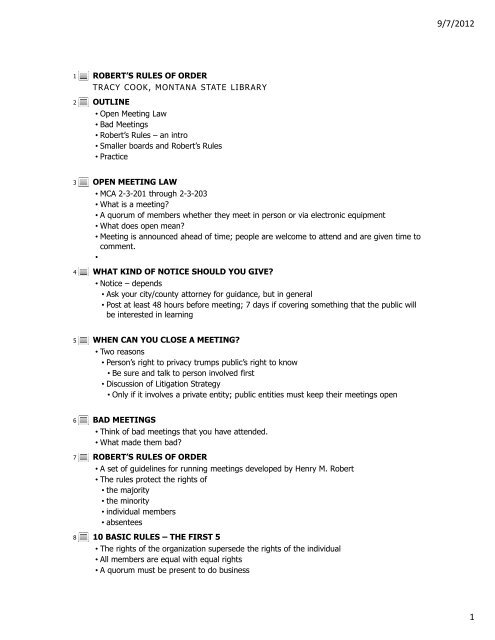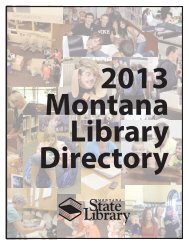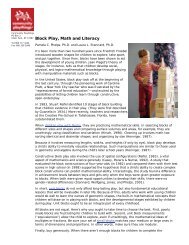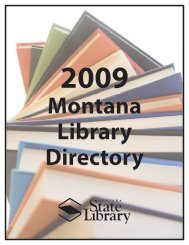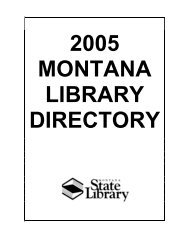Robert's Rules of Order
Robert's Rules of Order
Robert's Rules of Order
You also want an ePaper? Increase the reach of your titles
YUMPU automatically turns print PDFs into web optimized ePapers that Google loves.
9/7/2012<br />
1<br />
2<br />
ROBERT’S RULES OF ORDER<br />
TRACY COOK, MONTANA STATE LIBRARY<br />
OUTLINE<br />
• Open Meeting Law<br />
• Bad Meetings<br />
• Robert’s <strong>Rules</strong> – an intro<br />
• Smaller boards and Robert’s <strong>Rules</strong><br />
• Practice<br />
3<br />
4<br />
OPEN MEETING LAW<br />
• MCA 2-3-201 through 2-3-203<br />
• What is a meeting<br />
• A quorum <strong>of</strong> members whether they meet in person or via electronic equipment<br />
• What does open mean<br />
• Meeting is announced ahead <strong>of</strong> time; people are welcome to attend and are given time to<br />
comment.<br />
•<br />
WHAT KIND OF NOTICE SHOULD YOU GIVE<br />
• Notice – depends<br />
• Ask your city/county attorney for guidance, but in general<br />
• Post at least 48 hours before meeting; 7 days if covering something that the public will<br />
be interested in learning<br />
5<br />
WHEN CAN YOU CLOSE A MEETING<br />
• Two reasons<br />
• Person’s right to privacy trumps public’s right to know<br />
• Be sure and talk to person involved first<br />
• Discussion <strong>of</strong> Litigation Strategy<br />
• Only if it involves a private entity; public entities must keep their meetings open<br />
6<br />
7<br />
8<br />
BAD MEETINGS<br />
• Think <strong>of</strong> bad meetings that you have attended.<br />
• What made them bad<br />
ROBERT’S RULES OF ORDER<br />
• A set <strong>of</strong> guidelines for running meetings developed by Henry M. Robert<br />
• The rules protect the rights <strong>of</strong><br />
• the majority<br />
• the minority<br />
• individual members<br />
• absentees<br />
10 BASIC RULES – THE FIRST 5<br />
• The rights <strong>of</strong> the organization supersede the rights <strong>of</strong> the individual<br />
• All members are equal with equal rights<br />
• A quorum must be present to do business<br />
1
9/7/2012<br />
•<br />
• A simple majority rules unless otherwise stipulated in the bylaws<br />
• Silence means consent<br />
9<br />
10<br />
11<br />
12<br />
1<br />
2<br />
1<br />
2<br />
THE SECOND 5 RULES<br />
• Two-thirds vote rule – necessary when limiting or taking away the rights <strong>of</strong> members<br />
• Motions must receive full debate – no motion to vote may be made if members wish to<br />
continue debate unless 2/3 agree<br />
• One question at a time – one speaker at a time<br />
• Once a decision is made an identical motion may not be brought forward at the same<br />
meeting<br />
• Personal remarks ARE always out <strong>of</strong> order<br />
MOTIONS – THE HEART OF THE RULES<br />
• Main Motion – how business is brought forward<br />
• Secondary motions<br />
• Subsidiary – changes or disposes <strong>of</strong> main motions<br />
• Privileged – not related to main motion, but matters <strong>of</strong> immediate importance<br />
• Incidental motions – procedural questions<br />
• Bring a question again before assembly<br />
MAIN MOTIONS – THE PROCESS<br />
1. Someone makes a motion<br />
2. Chair restates motion and asks for a second<br />
3. Someone else seconds the motion<br />
4. Chair says “it’s been moved and seconded that (restate motion)<br />
5. Chair asks if there is discussion<br />
6. Discussion<br />
7. Chair asks for vote<br />
8. Chair announces result <strong>of</strong> vote<br />
• SMALL BOARD ALERTS (less than 12 people)<br />
• Can discuss issue before making a motion<br />
• Don’t have to have a second<br />
• Members may speak any number <strong>of</strong> times<br />
• Chair can participate in the discussion<br />
THE DETAILS…..<br />
Process<br />
• Someone makes a motion<br />
• Chair restates and asks for a second<br />
• Someone seconds<br />
• Discussion<br />
3<br />
4<br />
Problem<br />
• What if the motion is unclear<br />
• What if the chair restates the motion incorrectly<br />
• What if no one seconds the motion<br />
• What are some <strong>of</strong> the problems that arise in a discussion<br />
•<br />
13<br />
THE DETAILS CONT….<br />
2
9/7/2012<br />
1<br />
2<br />
3<br />
4<br />
Process<br />
• Chair calls for vote<br />
• Aye<br />
• Nay<br />
• Abstain<br />
• Chair summarizes results<br />
• Reporting <strong>of</strong> votes<br />
• Motion is adopted or lost<br />
• Results <strong>of</strong> motion if needed<br />
Problem<br />
• What if chair forgets to ask for no<br />
• What about abstentions Do we have to have them<br />
14<br />
15<br />
16<br />
17<br />
18<br />
19<br />
20<br />
PRACTICE<br />
SUBSIDIARY MOTIONS<br />
• Lay on the table – defers a motion for a more pressing matter (NOT used to kill a motion)<br />
• Postpone indefinitely – how you really kill a motion<br />
• Amend – for clarification<br />
• Refer to a Committee – committee investigates<br />
• Postpone definitely – deal with a motion at a certain time or after a certain event<br />
AMEND<br />
• AMENDMENTS MUST BE GERMANE<br />
• They can’t bring up a different question; must be related to the main motion<br />
• They shouldn’t change a motion to the point where voting yes would be the same as<br />
voting no on the original motion<br />
• Friendly Amendments – made when someone supports the main motion, but thinks it<br />
needs to be altered to be acceptable.<br />
AMENDMENTS (CONT.)<br />
• Primary and Secondary<br />
• Primary amendment: adds, strikes out, or substitutes words within original motion<br />
• Secondary amendment/amendment to the amendment: changes the wording <strong>of</strong> the<br />
primary Amendment<br />
GUIDELINES FOR AMENDMENTS<br />
• Can only have a primary and secondary amendment at any given time. Will have to deal<br />
with the secondary amendment before making changes to it.<br />
• Adopting to amend something = accepting the amendment. Still need to vote on (now)<br />
amended main motion<br />
• Rejecting amendment = main motion still exists in its original form<br />
SUBSIDIARY MOTIONS – PRACTICE TIME<br />
• Amend – for clarification<br />
• Refer to a Committee – committee investigates<br />
• Postpone definitely – deal with a motion at a certain time or after a certain event<br />
•<br />
•<br />
PRIVILEGED MOTIONS<br />
3
9/7/2012<br />
21<br />
22<br />
23<br />
• Call for <strong>Order</strong>s <strong>of</strong> the Day – call to conform to agenda<br />
• Raise a Question <strong>of</strong> Privilege – relates to immediate rights <strong>of</strong> member<br />
• Recess – intermission<br />
• Adjourn – end a meeting immediately<br />
INCIDENTAL MOTIONS<br />
• Point <strong>of</strong> order – correct a breach in rules<br />
• Chair decides if rules are being followed<br />
• Division <strong>of</strong> the Assembly – call for a revote if you doubt results<br />
• Suspend the <strong>Rules</strong> – set aside a parliamentary rule<br />
• Division <strong>of</strong> the question – divide a motion into smaller topics<br />
GENERAL/UNANIMOUS CONSENT<br />
• Used for noncontroversial issues<br />
• Paying bills<br />
• Approving minutes<br />
• Considering reports or correspondence<br />
• Can also be used to adjourn<br />
THANKS FOR YOUR TIME TODAY<br />
• Tracy Cook, Montana State Library<br />
• tcook@mtlib.org<br />
• 1-866-843-6524<br />
4


